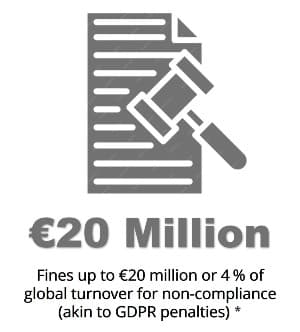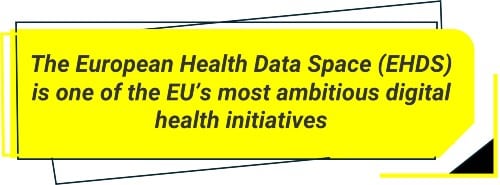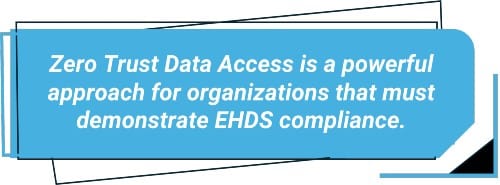
European Health Data Space compliance requires secure, auditable, and least-privilege access to health data, starting in 2029. Zero Trust Data Access enables organizations to meet these requirements while ensuring GDPR alignment and protecting sensitive health information.
European Health Data Space Compliance: What It Means and How Zero Trust Data Access Supports It
Estimated reading time: 3 minutes
Table of Contents

In this blog, we’ll explore what EHDS is, its implementation timeline, and how Zero Trust Data Access (ZTDA) can play a crucial role in helping organizations comply with its data protection and governance standards.
What Is the European Health Data Space?
The European Health Data Space (EHDS) is a legal and technical framework that aims to create a common European infrastructure for the access, exchange, and reuse of electronic health data. Its dual mission is to:

- Enable secure secondary use of health data for research, innovation, policy-making, and public health—under strict governance and privacy safeguards.
EHDS complements and reinforces the EU’s data protection laws, including the General Data Protection Regulation (GDPR), by introducing additional obligations for health data access, auditability, and data minimization.
EHDS Compliance Timeline
The EHDS regulation entered into force on March 26, 2025, with implementation taking place over the next several years:
| Year | EHDS Milestone |
| 2025–2026 | Member States develop governance structures and digital health authorities. |
| By 2029 | Cross-border access to patient summaries and e-prescriptions becomes mandatory. |
| By 2031 | Broader data categories (e.g., imaging, lab results, genomics) become shareable. |
| By 2034 | Secondary use of data extended to entities outside the EU. |
European Health Data Space compliance efforts must begin well before these dates, as healthcare providers, researchers, and IT vendors will need to redesign data access systems, governance processes, and security models.
What Does EHDS Compliance Require?
EHDS compliance includes a wide range of technical and organizational requirements, such as:
- Role-based and purpose-specific access controls
- Data minimization and privacy by design
- Detailed audit trails of all data access and sharing
- Consent management and data subject rights
- Security for cross-border data sharing without replication
These demands go far beyond traditional IT security. They require a data-centric security model—one that aligns perfectly with Zero Trust Data Access.
How Zero Trust Data Access Enables EHDS Compliance

Here’s how ZTDA helps:
-
Enforces Least-Privilege Access
ZTDA grants users the minimum access necessary, based on role and purpose. This aligns with EHDS and GDPR requirements for data minimization and lawful processing.
EHDS Compliance Impact: Prevents unauthorized or excessive access to sensitive health data.
-
Delivers Full Auditability
All access requests and usage events are logged with who, what, when, where, and why—creating tamper-proof audit trails.
EHDS Compliance Impact: Satisfies audit obligations and supports breach detection and investigation.
-
Applies Context-Aware Access Control
ZTDA factors in user identity, device security, location, and time before granting access.
EHDS Compliance Impact: Adds real-time enforcement and dynamic decision-making beyond static roles.
-
Enables Cross-Border Secure Access
ZTDA provides remote, file-level access to data—without requiring data replication or transfer between jurisdictions.
EHDS Compliance Impact: Supports secure cross-border primary use while preserving data residency.
-
Supports Role Segregation and Purpose Limitation
Researchers, clinicians, and administrators can each be granted purpose-specific access under distinct conditions.
EHDS Compliance Impact: Helps enforce separation of duties and ensures access aligns with the legal basis and use case.
-
Helps Prevent Data Breaches and Ransomware
By limiting lateral movement and applying real-time monitoring, ZTDA helps prevent breaches and attacks before they escalate.
EHDS Compliance Impact: Aligns with GDPR Article 32 and EHDS cybersecurity mandates.
Conclusion: ZTDA as a Foundation for EHDS Compliance
The road to European Health Data Space compliance is complex—but it is also a vital opportunity to modernize how health data is protected, governed, and accessed across the EU.
Zero Trust Data Access provides the technical foundation needed to meet EHDS requirements for secure, auditable, and purpose-based data use. It protects privacy, enables cross-border workflows, and helps organizations stay ahead of the curve as EHDS enforcement begins.
If your organization handles electronic health records or research data in the EU, the time to prepare is now.
Want to learn more about Zero Trust Data Access and EHDS compliance?
Contact us to see how we can help you build a secure, compliant, and future-ready data architecture.
Learn More About FileFlexFrequently Asked Questions (FAQ)
1. What is the European Health Data Space (EHDS)?
The European Health Data Space (EHDS) is an EU-wide framework that enables the secure sharing and reuse of electronic health data across member states. It aims to improve healthcare delivery, support cross-border treatment, and foster research and innovation under strict privacy and governance rules.
2. When does EHDS compliance become mandatory?
EHDS entered into force in March 2025, with phased implementation:
- By 2029: Primary use (e.g., patient data access across borders) becomes mandatory.
- By 2031: Broader data categories must be accessible.
- By 2034: Secondary data use may be extended to international organizations.
3. How does Zero Trust Data Access help with EHDS compliance?
Zero Trust Data Access (ZTDA) enforces least-privilege, role-based, and context-aware access controls. It provides full audit trails, prevents data overexposure, and enables secure, cross-border access without duplication—supporting key EHDS and GDPR compliance requirements.
4. Who needs to comply with the EHDS regulation?
Healthcare providers, researchers, public health institutions, health IT vendors, and any organization that processes electronic health data within the EU—or accesses such data across EU borders—must ensure compliance with EHDS.